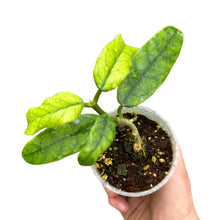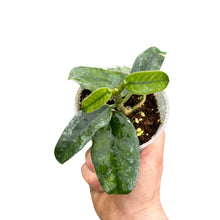9cm potted plant in a coco husk plug with coco coir, coco chips, perlite and pine bark. We do not recommend removing the plant from the coco husk plug.
The picture shown is an example of what's in stock. You will receive a plant as close to the picture and description as possible.
Hoya globulosa is part of the Apocynaceae family and its native range is Himalaya to China (Yunnan to Guangdong) and Indo-China, elevation of 400–1000m in montane areas. This Hoya was described in 1882 in The Gardener’s Chronicle, “...from the Sikkim Himalaya, where it was discovered by Sir Joseph Hooker, who is the sponsor for the name.”
The pubescent leaves are dark green, obovate-lanceolate with wavy leaf margins, vention is pinnate. They produce up to 40 flowers per umbel, they have white corollas and white coronas with some red.
Genus name is new Latin, named after Thomas Hoy ( c. 1750– c. 1821), English gardener. Specific epithet is Latin, meaning globular, this is possibly in reference to the spherical cluster of flowers it produces.
Light: Bright indirect light, meaning the plant sees the sun for 0-4 hours per day - this could be through trees or a translucent curtain, it’s important for the plant to see the sky in order to thrive.
Water: Given adequate light, keep the potting mix evenly moist, the potting mix is traditionally quite chunky, water will usually flow through quite easily. It's important to allow this plant to dry out more during winter.
Potting mix: A chunky well draining mix composed of coco coir, perlite or vermiculite, orchid bark, sphagnum moss and worm castings; you could also add some horticultural charcoal to this epiphytic mix. Alternatively, you can pot in a mix of coco chips and perlite.
Fertilising: Feed your plant every few waterings during the growing season or when you observe active growth. You can dilute fertiliser to half the recommended amount but never add more.
Temperature: 10-25˚C, keeping cooler in the evenings and in winter.
Humidity: Hoya prefer higher humidity, between 60-80% - they definitely grow better in higher humidity.
Hoya aren’t considered toxic, however, they may make your pet or child vomit if ingested, keep out of reach just to be safe.
For further information about Hoya, check out our blog.



